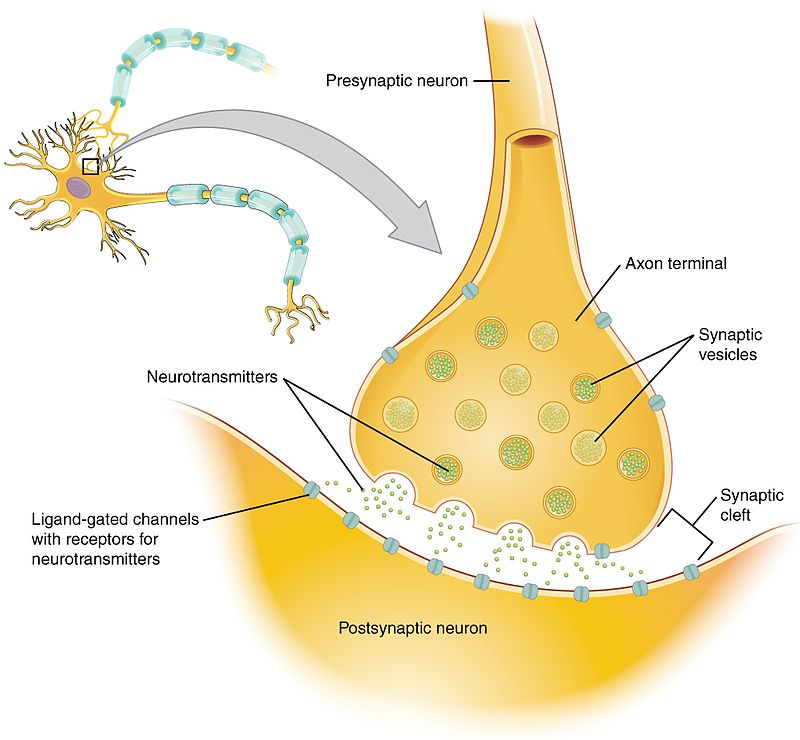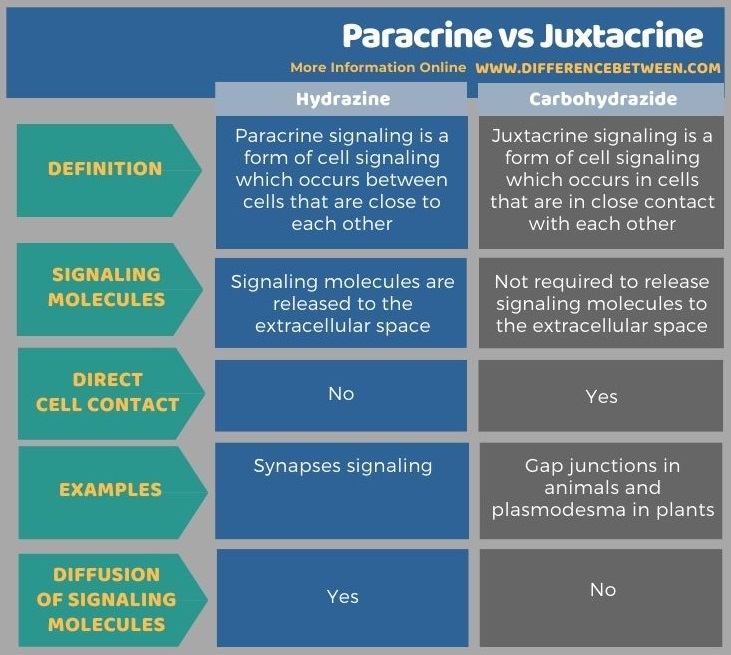The key difference between paracrine and juxtacrine is that paracrine signaling requires the release of signaling molecules into extracellular space and the diffusion of them in the space while juxtacrine signaling requires close contact of cells.
Cells communicate with each other via cell signaling. One cell sends a signal to the receiving cell. Likewise, cells send and receive millions of messages in the form of chemical signaling molecules. Cell signaling helps cells to detect what is happening around them. Cells use these chemical signals to communicate. Chemical signals also known as ligands are basically proteins and other molecules produced by the sending cell. The target cell should have a receptor in order to receive the chemical signal. There are four basic types of cell signaling in multicellular organisms. They are paracrine signaling, autocrine signaling, endocrine signaling, and juxtacrine signaling. They differ based on the distance the signal travels through the organism to reach the target cell.
CONTENTS
1. Overview and Key Difference
2. What is Paracrine
3. What is Juxtacrine
4. Similarities Between Paracrine and Juxtacrine
5. Side by Side Comparison – Paracrine vs Juxtacrine in Tabular Form
6. Summary
What is Paracrine?
Paracrine signaling is a form of cell signaling which occurs between cells that are close to each other. Cells release signaling molecules to extracellular space. Then they diffuse through space and reach the target cells. Ligands bind with the receptors of the target cells. Paracrine signaling helps cells to communicate over relatively short distances. It allows cells to locally coordinate activities with their neighboring cells.

Figure 01: Paracrine Signaling – Synapse Signaling
Nerve impulse transmission between two neurons through a synapse is an example for paracrine signaling. Presynaptic neuron releases neurotransmitters, which are signaling molecules or ligands. Neurotransmitters travel through the synapse and reach and bind with the receptors of the postsynaptic neuron and transfer the signal to it.
In addition to neurotransmitters, growth factor and clotting factors are paracrine signaling agents. Hence, paracrine signaling plays a key role in the development of tissues. Moreover, paracrine signaling is involved in responses to allergens, tissue repair, the formation of scar tissue, and blood clotting.
What is Juxtacrine?
Juxtacrine signaling is a form of cell signaling which occurs between adjacent cells. Unlike in paracrine signaling, cells should be in close contact with each other for juxtacrine signaling. In bacteria, juxtacrine signaling refers to interaction by direct cell membrane contact. It is necessary to place cell-specific ligands on the surface of the signaling cell in order to bind with an appropriate cell surface receptor of the adjacent cell. Therefore, ligand on one cell surface binds with the receptor on the surface of the next cell.

Figure 02: Juxtacrine Signaling
There are three types of juxtacrine signaling. In one type, a protein on one cell binds to its receptor on the surface of the adjacent cell. In the second type, a receptor on one cell binds to its ligand on the extracellular matrix secreted by another cell. In the third type, the signal is transmitted directly from the cytoplasm of one cell through small conduits into the cytoplasm of an adjacent cell. Gap junctions in animals and plasmodesma in plants are involved in juxtacrine signaling.
What are the Similarities Between Paracrine and Juxtacrine?
- Paracrine and juxtacrine signaling are two types of cell signaling.
- In both forms of cell signaling, ligands bind with the receptors of the receiving cell.
- Both facilitate communication between cells.
What is the Difference Between Paracrine and Juxtacrine?
Paracrine signaling requires the release of signaling molecules to the extracellular space in order to diffuse and reach the receiving cell. Juxtacrine signaling does not require the release and diffusing of signaling molecules in the extracellular space. It requires only direct contact between the cells. Thus, this is the key difference between paracrine and juxtacrine.
Below info-graphic compares both signalling and tabulates the important differences between paracrine and juxtacrine.

Summary – Paracrine vs Juxtacrine
Paracrine and juxtacrine signaling are two forms of cell signaling. Paracrine signaling occurs between the cells that are close to each other. Juxtacrine signaling occurs between cells that are in direct or close contact with each other. The release of signaling molecules to extracellular space and the diffusion of signaling molecules through the space towards the receiving cell are required in paracrine signaling. But, in juxtacrine signaling, ligands on the cell surface bind with the appropriate receptors located on the surface of the receiving cell. Hence, the diffusion of signaling molecules is not required in juxtacrine signaling. Thus, this summarizes the difference between paracrine and juxtacrine.
Reference:
1. “Introduction to Cell Signaling (Article).” Khan Academy, Available here.
2. Gilbert, Scott F. “Juxtacrine Signaling.” Developmental Biology. 6th Edition., U.S. National Library of Medicine, 1 Jan. 1970, Available here.
Image Courtesy:
1. “1225 Chemical Synapse” By Young, KA., Wise, JA., DeSaix, P., Kruse, DH., Poe, B., Johnson, E., Johnson, JE., Korol, O., Betts, JG., & Womble, M. – (CC BY 4.0) via Commons Wikimedia
2. “Notchccr” By Fred the Oysteri The source code of this SVG is valid. created with Adobe Illustrator. – Graphic: National Institute of Health. U.S. (Public Domain) via Commons Wikimedia
ncG1vNJzZmivp6x7pbXFn5yrnZ6YsqOx07CcnqZemLyue8OinZ%2Bdopq7pLGMm5ytr5Wau268wKuYnKqZo7Jurc2dZKOtqKmupL7Ip5xo